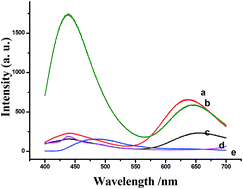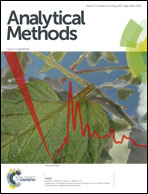A fluorescent sensor based on ovalbumin-modified Au nanoclusters for sensitive detection of ascorbic acid
Abstract
In this paper, ovalbumin (OVA) stabilized gold nanoclusters (OVA-Au NCs) were used as sensing probes for ascorbic acid (AA) detection. The fluorescence of Au NCs was found to be quenched effectively through the change in the oxidation state of Au NCs by AA. Upon the addition of AA under optimal conditions, the fluorescence intensity quenched linearly with the logarithm of AA concentration over the range of 1.0 nM to 100 μM with a detection limit (LOD, S/N = 3) of 0.5 nM. Results indicated that the proposed method gives a good sensitivity and simple operation for detecting AA. This work also has promising potential for protein-modified Au NCs.


 Please wait while we load your content...
Please wait while we load your content...